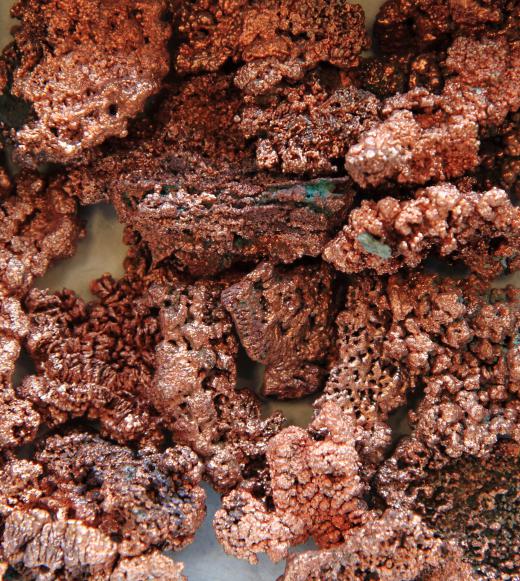A reverberatory furnace is a type of smelting or metal-refining furnace that has been used since the mid-17th century and is more commonly known as an open-hearth furnace. It melts metal-containing ore by generating hot gasses near the roof of the furnace without the metal ever coming into direct contact with the fuel source that is used to heat it. Because a reverberatory furnace is a centuries-old design and has a limited temperature range, it is usually used to smelt non-ferrous, softer metals than iron, such as copper, aluminum, and tin. The furnace design has also been used to smelt nickel and more environmentally-risky metals such as lead, which has given it a negative reputation for the amount of air pollution that it can generate.
Industrial furnaces can have complex or simple designs based on the precise amount of temperature control that they must have and the types of ore that they process. The reverberatory furnace is a rather simple model that has a usually rectangular enclosed chamber with a depression in the bottom center known as a hearth. Heated flames or hot gasses are directed across the hearth from above, and exhaust gasses are then channeled out of the furnace through one or more flues along the far side. As the hot gasses and flames are piped into the furnace chamber, the opposite wall acts as a baffle off of which they bounce in order to continue circulating in the chamber. One of the primary design needs for a reverberatory furnace is that the path for the burning fuel be as long and as obstruction-free as possible, as this allows for more intense heating of the interior and rapid melting of the ore.

While a metallurgical furnace can rely on any of the three types of heat transfer to smelt ore, from conduction to convection and radiation, usually conduction or the transfer of heat from one solid surface to another is most efficient. The reverberatory furnace in contrast relies almost entirely on convection and radiation where the heat is transferred to the ore through the surrounding air. This means that a reverberatory furnace takes much more fuel to heat and smelt ore than a refractory one does that relies on the ambient heat retained in fireclay bricks to smelt metal. Softer metals such as bronze or compounds like glass are typically processed in a reverberatory furnace as they have lower melting points, though some reverberatory designs have also been used to process steel in special cases.
Though improvements to the reverberatory furnace, such as making the roof structure out of refractory brick to increase the heat level, have made them a more versatile class of process furnace, they have retained much of their centuries-old design. The reverberatory name itself comes from the arching shape to the center of the roof that allows hot gasses to flow upwards and then bounce back down into the furnace center. The location of the flue or flues for exhaust gasses are generally at the lowest point of the roof and the highest point of the roof arch is immediately over where the fire and hot gasses are piped in. These changes have increased the temperature range of the reverberatory furnace, which can give the exterior roof structure a sort of oblong, whale-shaped look to it.
The reverberatory furnace is a general form of the puddling furnace, which uses the same principle of heating by hot gasses to smelt iron ore. A primary use for reverberatory furnaces as of 2011, however, is to smelt the soft metal of lead into pure lead. These furnaces have several potential weaknesses where the surrounding environment can be contaminated by lead. These include the furnace operating under positive pressure, emissions caused by dust and fume leaks since the furnace is not an entirely sealed chamber, and releases of lead into the environment when ore is funneled into the furnace and slag or pure metal is removed.
